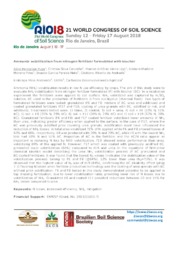Ammonia volatilization from nitrogen fertilizer formulated with biochar.
Ammonia volatilization from nitrogen fertilizer formulated with biochar.
Autoria: PUGA, A. P.; CARVALHO, C. S.; LIGO, M. A. V.; PIRES, A. M. M.; PEREIRA NETO, B. G.; ANDRADE, C. A. de
Resumo: Ammonia (NH3) volatilization results in low N use efficiency by crops. The aim of this study were to evaluate NH3 volatilization from nitrogen fertilizer formulated (F) with biochar (BC). In a incubation experiment the fertilizers were applied to soil surface. NH3 volatilized was captured by H2SO4 solution. BC used in the production of fertilizers is from eucalyptus (charcoal fines). Two types of formulated fertilizers were tested: granulated (F6 and F8; mixture of BC, urea and additives) and coated granulated fertilizers (F17 and F19; coating of urea granule with BC, acidified or not, and additives). Treatments tested were: 1) blank; 2) control; 3) soil + urea; 4) soil + F6 (10% N, 51% BC); 5) soil + F8 (20% N, 29% BC); 6) soil + F17 (20% N, 29% BC) and 7) soil + F19 (32% N, 20% BC). Granulated fertilizers (F6 and F8) and F17 coated fertilizer volatilized lower amounts of NH3 than urea, indicating greater efficiency when applied to the surface. In the case of F17, where the BC was previously acidified prior covering urea granule, acidification must have influenced the reduction of NH3 losses. In total urea volatilized 71% of N applied while F6 and F8 showed losses of 60% and 66%, respectively. F8 was produced with 20% N and 29% BC, while F6 with the lowest NH3 loss had 10% N and 51% BC. Proportion of BC in the fertilizer and the BC/N ratio appear as important in reducing N loss by NH3 volatilization. F19 showed worse performance than urea, volatilizing 80% of the applied N. However, F17 which was coated with previously acidified BC, presented lower volatilization (64%) compared to F19 and urea. In the equations of first-order chemical kinetics model describing the urea NH3 volatilization process of BC granulated and BC-coated fertilizers, it was found that the lowest N0 values (indicates the stabilization value of the volatilization process) belong to F6 and F8 (@64%), 12% lower than urea (N0=73%). It was observed that the highest value of N0 was of F19 (84%), confirming the BC alkalinity effect (pH@ 7.7) favoring N losses when fertilizer production technology was the coating of urea granule with BC without prior acidification. F6 and F8 tested in this study demonstrated potential to be applied in top dressing fertilization, due to lower volatilization rates, providing lower risk of N losses due to volatilization of NH3. Granulated F6 and coated F17 provided reductions between 10 and 15% for NH3 losses compared to urea.
Ano de publicação: 2018
Tipo de publicação: Resumo em anais e proceedings
Unidade: Embrapa Meio Ambiente
Palavras-chave: Increased efficiency, Mitigation, N losses, NH3
Observações
1 - Por padrão são exibidas publicações dos últimos 20 anos. Para encontrar publicações mais antigas, configure o filtro ano de publicação, colocando o ano a partir do qual você deseja encontrar publicações. O filtro está na coluna da esquerda na busca acima.
2 - Para ler algumas publicações da Embrapa (apenas as que estão em formato ePub), é necessário ter, no celular ou computador, um desses softwares gratuitos. Sistemas Android: Google Play Livros; IOS: iBooks; Windows e Linux: software Calibre.
Acesse outras publicações
Acesse a Base de Dados da Pesquisa Agropecuária (BDPA) para consultar o acervo completo das bibliotecas da Embrapa.

